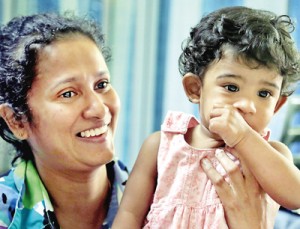Saving Surangi
No fuss, no crowd. A simple ‘handover’ amidst the busy routine of Ward 3 of the De Soysa Hospital for Women in Colombo. A family of four – mother, father and two daughters, the younger just a year-old – presents a contraption which would allow expectant mothers to comfortably have their meals sitting up in bed itself. Another gift is an emergency drug trolley.

Surangi and Peige. Pix by M.A. Pushpa Kumara
A few minutes and the family is on its way, while hospital Director Dr. Dhammika Jayalath, Ward 3’s Consultant Obstetrician and Gynaecologist Prof. Hemantha Senanayake and a few junior doctors and nurses also get about their work. It is December 30, and next day (December 31), the family would be celebrating their younger daughter, Peige’s first birthday.
Earlier, in February 2013, they had donated Rs. 200,000 to the Colombo Medical Faculty to “protect the system which produces doctors” who dedicate their lives to the people of Sri Lanka.The family’s bond with Ward 3 of the DMH, as this hospital is popularly known, began a little over a year ago and if not for the expertise, skill and care of both the medical and nursing staff, the mother, Surangi Udugama, may not have been alive today.
Fourteen long days and nights she spent at the DMH and all the urgings by father Posantha Siriwardane to their elder daughter, five-plus Hannah to “go look at the bed on which Amma stayed” cannot persuade her to do so. Maybe the memory of her mother’s illness is too fresh and raw yet.
Yes, it was touch-and-go for Surangi. It is Posantha who tells MediScene the tale. Hannah had been born through a Caesarian, for Surangi had some issues with her heart. Now living in Dubai, as Posantha is working as an Aircraft Engineer there, it was in 2012 that Surangi became pregnant with their second baby. Visits to a private hospital began and it was in the seventh-month of pregnancy that a Swedish doctor working there suggested a 3-dimensional Doppler scan to check the baby’s heart.
It was then that Surangi’s “dangerous” condition was diagnosed – it was placenta accreta and she was referred to a government hospital with facilities to deal with this situation, on October 20, 2012. By now Posantha had been told the reality that Surangi “may lose her life with this pregnancy”. The situation was “terrible”, according to Posantha for the doctor to whom Surangi was referred would not be available for two weeks.
Having been requested “not to bring Surangi back” to the private hospital, “we had no place to go to”, says Posantha, adding that it was then that he decided to fly back to Colombo that very night. With Surangi forgetting to take her tablets in the rush, she had heart palpitations on the flight and was taken to the Katunayake Airport’s Medical Centre where she underwent thorough screening before being transferred to the Negombo Hospital by ambulance. After being stabilized there, Posantha had decided to take her to a private hospital in Colombo.
When the Outpatients Department doctor, on seeing the heart reports and scans of Surangi who was 28 weeks pregnant, made a round of calls to Specialists, no one was willing to risk taking her as their patient, says Posantha.It was senior Consultant Obstetrician and Gynaecologist, Prof. Harsha Seneviratne, who agreed. Although it was around midnight, he came to the hospital immediately. After scanning her, Prof. Seneviratne confirmed that it was a very serious situation and such mothers generally may not make it, Posantha says.
Prof. Seneviratne also suggested that for the management of this life-threatening pregnancy, Surangi should be taken to the DMH. When they agreed, he had put them in touch with Prof. Hemantha Senanayake who planned to do the Caesarian-section (C-section) on December 28.Until December Surangi had to go in for regular check-ups. When she experienced some spotting on December 22, she had been admitted immediately and instructed to have bed-rest.
Surangi’s life hanging in the balance, the proof of the expertise of the doctors and also the care of the nurses headed by Sr. Anna is that the Caesarian was a success and baby Peige was born on December 31, 2012. Surangi who had to be in the Intensive Care Unit for 14 long days, saw her little one only five days after delivery.
The DMH is not five-star, but it saves lives, says Posantha, while Surangi adds: “It was a miracle.”
“I am alive today because of Jesus and Prof. Hemantha Senanayake,” she reiterates.


